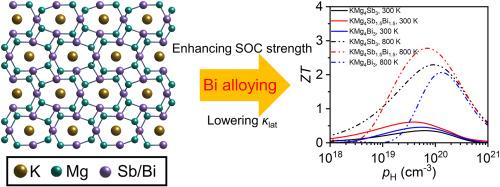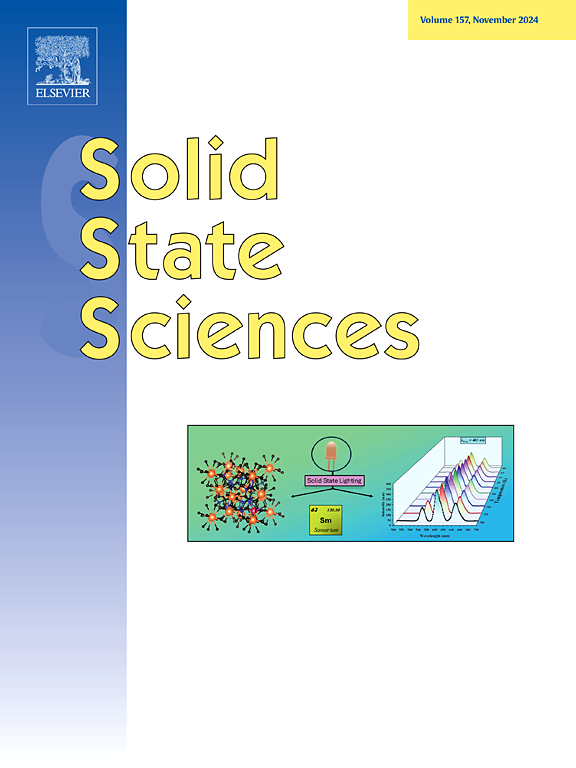p型热电KMg4Sb3-xBix中自旋轨道耦合驱动的拓扑跃迁:DFT研究
IF 3.3
3区 化学
Q2 CHEMISTRY, INORGANIC & NUCLEAR
引用次数: 0
摘要
本文报道了KMg4Sb3-xBix(0≤x≤3)Zintl化合物的理论研究,重点关注Bi含量的增加如何调节能带拓扑和输运性质。密度泛函理论(DFT)带结构计算表明,铋取代系统地缩小了带隙,使价带边缘变得锋利。特别是,KMg4Sb3是一种宽隙半导体,而KMg4Bi3具有经过拓扑跃迁的闭合隙。人为缩放KMg4Sb3(0 - 300%)中自旋轨道耦合(SOC)强度,再现了铋诱导的带结构演化,证实了SOC是驱动因素。声子和玻尔兹曼输运计算表明,x = 1.5的样品最大程度地抑制了晶格热导率,同时增强了载流子迁移率。因此,在适当的p型掺杂下,中间合金kmg4sb1.5 . bi1.5在300 K和800 K时获得了超高的ZT ~ 0.5和~ 2.7。我们的工作建立了“soc调谐拓扑转换”作为一般设计策略,将声子玻璃结构与拓扑带工程结合起来,以实现高效热电材料。本文章由计算机程序翻译,如有差异,请以英文原文为准。

Spin-orbit coupling driven topological transition in p-type thermoelectric KMg4Sb3-xBix: a DFT study
We report a theoretical study of the KMg4Sb3-xBix (0 ≤ x ≤ 3) Zintl compounds, focusing on how increasing Bi content tunes the band topology and transport properties. Density-functional theory (DFT) band structure calculations show that Bi substitution systematically narrows the band gap and sharpens the valence-band edge. In particular, KMg4Sb3 is a wide-gap semiconductor, whereas KMg4Bi3 has a closed gap that undergoes a topological transition. Artificially scaling the spin-orbit coupling (SOC) strength in KMg4Sb3 (0–300 %) reproduces the Bi induced evolution of band structures, confirming that SOC is the driving force. Phonon and Boltzmann-transport calculations show that the sample of x = 1.5 maximally suppresses lattice thermal conductivity, while enhancing carrier mobility. Consequently, the intermediate alloy KMg4Sb1.5Bi1.5 achieves an ultrahigh ZT∼0.5 at 300 K and ∼2.7 at 800 K under proper p-type doping. Our work establishes “SOC-tuned topological transition” as a general design strategy, uniting phonon-glass architectures with topological band engineering to achieve high-efficiency thermoelectric materials.
求助全文
通过发布文献求助,成功后即可免费获取论文全文。
去求助
来源期刊

Solid State Sciences
化学-无机化学与核化学
CiteScore
6.60
自引率
2.90%
发文量
214
审稿时长
27 days
期刊介绍:
Solid State Sciences is the journal for researchers from the broad solid state chemistry and physics community. It publishes key articles on all aspects of solid state synthesis, structure-property relationships, theory and functionalities, in relation with experiments.
Key topics for stand-alone papers and special issues:
-Novel ways of synthesis, inorganic functional materials, including porous and glassy materials, hybrid organic-inorganic compounds and nanomaterials
-Physical properties, emphasizing but not limited to the electrical, magnetical and optical features
-Materials related to information technology and energy and environmental sciences.
The journal publishes feature articles from experts in the field upon invitation.
Solid State Sciences - your gateway to energy-related materials.
 求助内容:
求助内容: 应助结果提醒方式:
应助结果提醒方式:


